Sol Invictus
Sol Invictus (Classical Latin: [s̠oːl ɪnˈwɪk.t̪ʊs̠], "Unconquered Sun"), sometimes known as Helios, was long considered to be the official sun god of the later Roman Empire. In recent years, however, the scholarly community has become divided on Sol between traditionalists and a growing group of revisionists.[2]
| Sol Invictus | |
|---|---|
Sun god | |
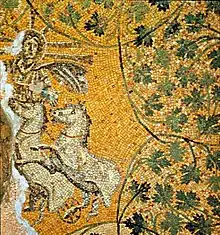 Mosaic of Sol in Mausoleum M in the Vatican Necropolis[1] | |
| Other names | Elagabalus |
| Major cult center | Temple of the Sun |
| Abode | The sky |
| Planet | Sun |
| Symbols | Sunburst, halo, radiate crown |
| Day | Sunday |
| Gender | Male |
| Festivals | Festival of Dies Natalis Solis Invicti |
| Equivalents | |
| Palmyran equivalent | Shams |
In the traditional view, Sol Invictus was the second of two entirely different sun gods in Rome. The first of these, Sol Indiges, or Sol, was an early Roman deity of minor importance whose cult had petered out by the first century AD. Sol Invictus, on the other hand, was a Syrian sun god whose cult was first promoted in Rome under Elagabalus, without success. Some fifty years later, on 25 December AD 274, the Roman emperor Aurelian did succeed to establish the cult of Sol Invictus as an official religion, alongside the traditional Roman cults.
Although the Syrian origin of Sol Invictus is undisputed in the traditional view, there has never been consensus on which Syrian solar deity he was: Some scholars opt for the sky god of Emesa, Elagabalus,[3] while others prefer Malakbel of Palmyra.[4][5] There was general agreement that, from Aurelian to Constantine I, Sol was of supreme importance, until Constantine abandoned Sol in favor of Christianity.[lower-alpha 1] The last inscription referring to Sol Invictus dates to AD 387,[6] and there were enough devotees in the fifth century that the Christian theologian Augustine found it necessary to preach against them.[7]
In the revisionist view, there was only one cult of the Sun God in Rome, continuous from the monarchy to the end of antiquity. This was a Roman god who was simply called Sol. There were at least three temples of the Sun god in Rome, all active during the Empire and all dating from the earlier Republic.[8] They claim that there was never a separate solar deity named Sol Invictus.[9][10][11]
Invictus as epithet
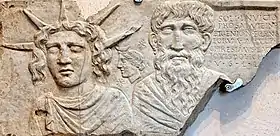
Invictus ("unconquered, invincible") was an epithet utilized for several Roman deities, including Jupiter, Mars, Hercules, Apollo, and Silvanus.[2]: 124 It had been in use from the 3rd century BC.[11]: 18 The Roman cult to Sol is continuous from the "earliest history" of the city until the institution of Christianity as the exclusive state religion. Scholars have sometimes regarded the traditional Sol Indiges and Sol Invictus as two separate deities, but the rejection of this view by S. E. Hijmans has found supporters.[13]
An inscription of AD 102 records a restoration of a portico of Sol in what is now the Trastevere area of Rome by a certain Gaius Iulius Anicetus.[11]: Chapter 5: pp483–508 While he may have had in mind an allusion to his own cognomen, which is the Latinized form of the Greek equivalent of invictus, ἀνίκητος (anikētos),[11]: 486, footnote 22 the earliest extant dated inscription that uses invictus as an epithet of Sol is from AD 158.[lower-alpha 2] Another, stylistically dated to the 2nd century, is inscribed on a Roman phalera (ornamental disk): INVENTORI LUCIS SOLI INVICTO AUGUSTO ("I glorify the unconquerable sun, the creator of light.")[16][lower-alpha 3] Augustus is a regular epithet linking deities to the Imperial cult.[18] Sol Invictus played a prominent role in the Mithraic mysteries, and was equated with Mithras.[19][20][21] The relation of the Mithraic Sol Invictus to the public cult of the deity with the same name is unclear and perhaps non-existent.[21]: 203
Elagabalus
According to the Historia Augusta, Elagabalus, the teenaged Severan heir, adopted the name of his deity and brought his cult image from Emesa to Rome. Once installed as emperor, he neglected Rome's traditional State deities and promoted his own as Rome's most powerful deity. This ended with his murder in 222. The Historia Augusta equates the deity Elagabalus with Jupiter and Sol: fuit autem Heliogabali vel Iovis vel Solis sacerdos, "He was also a priest of Heliogabalus, or Jove, or Sol".[22] While this has been seen as an attempt to import the Syrian sun god to Rome,[23] the Roman cult of Sol had existed in Rome at least since the early Republic.[2][26][10][11]
Aurelian
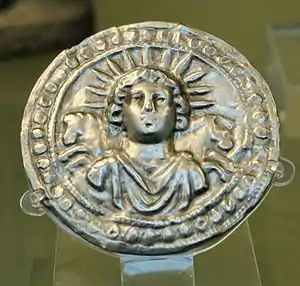
The Roman gens Aurelia was associated with the cult of Sol.[27] After his victories in the East, the Emperor Aurelian thoroughly reformed the Roman cult of Sol, elevating the sun-god to one of the premier divinities of the Empire. Where previously priests of Sol had been simply sacerdotes and tended to belong to lower ranks of Roman society,[11]: 504–505 they were now pontifices and members of the new college of pontifices instituted by Aurelian. Every pontifex of Sol was a member of the senatorial elite, indicating that the priesthood of Sol was now highly prestigious. Almost all these senators held other priesthoods as well, however, and some of these other priesthoods take precedence in the inscriptions in which they are listed, suggesting that they were considered more prestigious than the priesthood of Sol.[lower-alpha 4] Aurelian also built a new temple for Sol, which was dedicated on 25 December 274,[30] and brought the total number of temples for the god in Rome to (at least) four.[lower-alpha 5] He also instituted games in honor of the sun god, held every four years from 274 onwards.
The identity of Aurelian's Sol Invictus has long been a subject of scholarly debate. Based on the Augustan History, some scholars have argued that it was based on Sol Elagablus (or Elagabla) of Emesa. Others, basing their argument on Zosimus, suggest that it was based on the Šams, the solar god of Palmyra on the grounds that Aurelian placed and consecrated a cult statue of the sun god looted from Palmyra in the temple of Sol Invictus.[31] Forsythe (2012)[32] discusses these arguments and adds a third more recent one, based on the work of Steven Hijmans. Hijmans argues that Aurelian's solar deity was simply the traditional Greco-Roman SOL INVICTUS.[32]
Constantine

Emperors portrayed SOL INVICTUS on their official coinage, with a wide range of legends, only a few of which incorporated the epithet INVICTUS, such as the legend SOLI INVICTO COMITI, claiming the "Unconquered Sun" as a companion to the Emperor, used with particular frequency by Constantine.[lower-alpha 6] Statuettes of Sol Invictus, carried by the standard-bearers, appear in three places in reliefs on the Arch of Constantine. Constantine's official coinage continues to bear images of Sol until 325/326. A solidus of Constantine as well as a gold medallion from his reign depict the Emperor's bust in profile twinned (jugate) with Sol Invictus, with the legend INVICTUS CONSTANTINUS[lower-alpha 7]
Constantine decreed (March 7, 321)[lower-alpha 8] DIES SOLIS – the day of the Sun, "Sunday" – as the Roman day of rest
On the venerable day of the Sun let the magistrates and people residing in cities rest, and let all workshops be closed. In the country however persons engaged in agriculture may freely and lawfully continue their pursuits because it often happens that another day is not suitable for grain-sowing or vine planting; lest by neglecting the proper moment for such operations the bounty of heaven should be lost.[36][37]
Constantine's triumphal arch was carefully positioned to align with the colossal statue of Sol by the Colosseum, so that Sol formed the dominant backdrop when seen from the direction of the main approach towards the arch.[38]
Sol and later Roman Emperors
Berrens (2004)[10] deals with coin-evidence of Imperial connection to the Solar cult. Sol is depicted sporadically on imperial coins in the 1st and 2nd centuries AD, then more frequently from Septimius Severus onwards until AD 325–326. SOL INVICTUS appears on coin legends from AD 261, well before the reign of Aurelian.[lower-alpha 9]
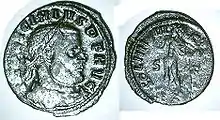 Identical reverse as the coin of Constantine I but with Emperor Licinius on head |
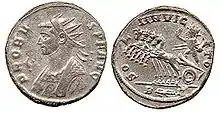 Coin of Emperor Probus, c. 280, with Sol Invictus riding a quadriga, with legend SOLI INVICTO, "to the Unconquered Sun": the Emperor (at left) wears a radiated solar crown, worn also by the god on the obverse |
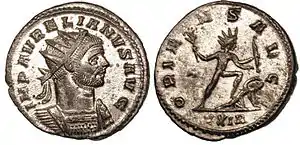 Aurelian in his radiate crown, on a silvered bronze coin struck at Rome, 274–275 |
Connections between the imperial radiate crown and the cult of Sol are postulated. Augustus was posthumously depicted with radiate crown, as were living emperors from Nero (after AD 65) to Constantine. Some modern scholarship interprets the imperial radiate crown as a divine, solar association rather than an overt symbol of Sol; Bergmann calls it a pseudo-object designed to disguise the divine and solar connotations that would otherwise be politically controversial[39]: 121–123 [40][11]: 80–84, 509–548 but there is broad agreement that coin-images showing the imperial radiate crown are stylistically distinct from those of the solar crown of rays; the imperial radiate crown is depicted as a real object rather than as symbolic light.[39]: 116–117 [11]: 82–83
Hijmans argues that the Imperial radiate crown represents the honorary wreath awarded to Augustus, perhaps posthumously, to commemorate his victory at the Battle of Actium; he points out that henceforth, living emperors were depicted with radiate crowns, but state divi were not. Hijmans believes this implies that the radiate crown of living emperors is a symbolic link to Augustus. His successors automatically inherited (or sometimes acquired) the same offices and honours due to Octavian as "saviour of the Republic" through his victory at Actium, piously attributed to Apollo-Helios.
Furthermore, radiate crowns were not solely worn by emperors: The wreaths awarded to victors at the Actian Games were radiate.[lower-alpha 10]
Festival of Dies Natalis Solis Invicti
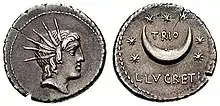
The Philocalian calendar of AD 354, part VI, gives a festival of NATALIS INVICTI on 25 December. There is limited evidence that this festival was celebrated before the mid-4th century.[42][lower-alpha 11][45] The same Philocalian calendar, part VIII, also mentions the birth of Jesus Christ, stating that the "Lord Jesus Christ was born eight days before the calends of January" (that is, on December 25).
Since the 12th century,[46] there have been speculations that the near-solstice date of 25 December for Christmas was selected because it was the date of the festival of DIES NATALIS SOLIS INVICTI, but historians of late antiquity make no mention of this, and others speculate Aurelian chose December 25 to shadow early Christian celebrations already on the rise.[47]
Legacy
Christianity
According to some historians, Christmas was set to December 25th because it was the date of the festival of Sol Invictus. This idea became popular especially in the 18th[48][49] and 19th centuries.[50]: 45 [51][52] Some argue that Christianity assimilated the religion of Sol Invictus and that Jesus himself was Sol Invictus.[53]
The charioteer in the mosaic of Mausoleum M has been interpreted by some as Christ. Clement of Alexandria had spoken of Christ driving his chariot across the sky.[54] This interpretation is doubted by others: "Only the cross-shaped nimbus makes the Christian significance apparent",[55] and the figure is seen by some simply as a representation of the Sun with no explicit religious reference whatever, pagan or Christian.[56][11]: 567–578
Judaism
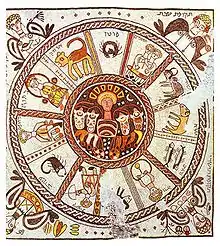
The traditional image of the Sun has also been used in early Jewish prophecy, poetry, and art. Psalm 19, begins "The heavens proclaim the glory of God, the firmament proclaims his handiwork", and likens the Sun to a bridegroom, to a warrior, and to the Torah.
An Aggadic legend found in tractate Avodah Zarah 8a contains the talmudic hypothesis that Adam the first established the tradition of fasting before the winter solstice, and rejoicing afterward, which festival later devolved into the Roman Saturnalia and Calenda.
A mosaic floor in Hamat Tiberias presents David as Helios surrounded by a ring with the signs of the zodiac.[57] As well as in Hamat Tiberias, figures of Helios or Sol Invictus also appear in several of the very few surviving schemes of decoration surviving from Late Antique synagogues, including Beth Alpha, Husefa, all now in Israel, and Naaran in the West Bank. He is shown in floor mosaics, with the usual radiate halo, and sometimes in a quadriga, in the central roundel of a circular representation of the zodiac or the seasons. These combinations "may have represented to an agricultural Jewish community the perpetuation of the annual cycle of the universe or ... the central part of a calendar". [58]: 370, 375
See also
- Astrological age
- Christ myth theory
- Christian views on astrology
- Christianity and paganism
- Esoteric Christianity
- Saturnalia
Footnotes
- "Up to the conversion of Constantine the Great, the cult of DEUS SOL INVICTUS received the full support of the emperors: The many coins showing the sun god that these emperors struck provide official evidence of this."[3]: 155 and "the custom of representing DEUS SOL INVICTUS on coins came to an end in AD 323."[3]: 169
- SOLI INVICTO DEO / EX VOTO SUSCEPTO / ACCEPTA MISSIONE / HONESTA EX NUME/RO EQ(UITUM) SING(ULARIUM) AUG(USTI) P(UBLIUS) / AELIUS AMANDUS / D(E)D(ICAVIT) TERTULLO ET / SACERDOTI CO(N)S(ULIBUS)[14]
Publius Aelius Amandus dedicated this to the god Sol Invictus in accordance with the vow he had made, upon his honorable discharge from the equestrian guard of the emperor, during the consulship of Tertullus and Sacerdos;
see[15][3]: [https://books.google.com/books?id=M1doAAAAMAAJ&q=%22Aelius+Amandus%22&dq=%22Aelius+Amandus%22 45] - An illustration is provided in[17]: 383, fig.34
- For a full list of the pontifices of Sol see J. Rupke (ed.), Fasti Sacerdotum (2005), p. 606. Memmius Vitrasius Orfitus lists his priesthoods as pontifex of Vesta, one of the quindecimviri sacris faciundis, and pontifex of Sol, in that order.[28] In a list of eight priesthoods, Vettius Agorius Praetextatus puts Pontifex Solis in third place.[29]
- The other three were in the Circus Maximus, on the Quirinal, and in Trastevere.[11]: Chapter 5
- A comprehensive discussion of all sol-coinage and sol-legends per emperor from Septimius Severus to Constantine can be found in Berrens (2004).[10]
- The medal is illustrated in Toynbee (1944);[33] the solidus is illustrated in Maurice (n.d.)[34]
- The civil edict of March 7, A.D. 321, was expressly issued by Constantine to command that "all judges and townships and all occupations of trade rest on the venerable day of the sun."[35]
- The coins issued under Elagabalus do not use INVICTUS for Roman Sol, nor for the Emesan Solar deity Elagabalus.[10]
- [11]: 509–548 A mosaic floor in the Baths of the Porta Marina at Ostia depicts a radiate victory crown on a table as well as a victorious competitor wearing one.[41]
- "An inscription of unique interest from the reign of Licinius embodies the official prescription for the annual celebration by his army of a festival of Sol Invictus on December 19".[43] The inscription[44] actually prescribes an annual offering to Sol on November 18 (DIE XIV KAL(ENDIS) DECEMB(RIBUS), i.e., on the fourteenth day before the Kalends of December).
References
- "Necropolis (Scavi) Tomb M". saintpetersbasilica.org. Archived from the original on 2011-07-24. Retrieved 2015-08-25.
- Hijmans, Steven (1996). "The sun that did not rise in the east". Babesch. 71: 115–150.
- Halsberghe, Gaston (1972). The Cult of Sol Invictus. Leiden: Brill.
- The Oxford Classical Dictionary (4th ed.). 2012. s.v. "Sol".
- Wissowa, Georg (1912). Religion und Kultus der Roemer (2nd ed.). Beck. pp. 365–368 – via Archive.org.
- "Corpus Inscriptionum Latinarum CIL VI, 1778 dates from AD 387"[3]: 170, n.3
- Augustine, Sermones, XII;[3]: 170, n.4 also in Ennaratio in Psalmum XXV; Ennaratio II, 3.
- Hijmans, Steven E. (2010). "Temples and priests of Sol in the city of Rome". Mouseion. 10 (3): 381–427. doi:10.1353/mou.2010.0073. S2CID 162381004 – via researchgate.net.
- Matern, Petra (2002). Helios und Sol: Kulte und Ikonographie des griechischen und römischen Sonnengottes (in German). Ege Yayınları. ISBN 978-975-8070-53-4. OCLC 53857589.
- Berrens, Stephan (2004). Sonnenkult und Kaisertum von den Severern bis zu Constantin I. (193–337 n. Chr.). Historia-Einzelschriften (Wiesbaden, Germany) (in German). Vol. 185. Stuttgart, Germany: Franz Steiner Verlag (Geschichte). ISBN 978-3-515-08575-5. OCLC 57010712.
-
Hijmans, Steven Ernst (2009). Sol: The Sun in the Art and Religions of Rome (PDF) (Thesis). Groningen, NL: University of Groningen. ISBN 978-90-367-3931-3. Retrieved 2021-06-17.
{{cite thesis}}: CS1 maint: url-status (link) p. 18, with citations from the Corpus Inscriptionum Latinarum. - Corpus Inscriptionum Latinarum CIL VI, 31181
- Hijmans (2009)[11]: Chapter 1 (a reworking of Hijmans (1996)); Matern (2001); Wallraff (2002); and Berrens (2004);[10] all follow Hijmans.
- Corpus Inscriptionum Latinarum CIL VI, 715 "CIL-VI-715 photograph". Archived from the original on 2011-07-16. Retrieved 2009-11-12.
- Campbell, J. (1994). The Roman army, 31 BC–AD 337: A sourcebook. p. 43.
- Guarducci, M. (1957–1959). "Sol invictus Augustus". Rendiconti della Pont. 3rd series. Accademia Romana di Archeologia. 30–31: 161 ff.
- Kantorowicz, E.H. (August 1961). "Gods in Uniform". Proceedings of the American Philosophical Society. 105 (4): 368–393.
- Brill, E.J. (1993). The Imperial Cult in the Latin West: Studies in the ruler cult of the western provinces of the Roman Empire (Second ed.). p. 87. ISBN 90-04-07180-6. Retrieved 29 May 2020 – via Google Books.
- Ulansey, David (1989). The Origins of the Mithraic Mysteries. Oxford University Press. p. 107.
- Salzman, Michele Renee (2004). "Pagan and Christian notions of the week in the 4th century CE western Roman Empire". Time and Temporality in the Ancient World. Museum of Archaeology and Anthropology. University of Pennsylvania. p. 192.
- Alvar, Jaime (2008). Romanising Oriental Gods: Myth, salvation, and ethics in the cults of Cybele, Isis, and Mithras. Translated by Gordon, Richard. Brill. p. 100.
- "Latin text". Historia Augusta. Translated by Thayer (English translation ed.). Loeb. 1, 5 – via Penelope, University of Chicago.
- See in particular Halsberghe (1972).
- Matern (2001)
- Wallraff (2002)
- [24][25]
- Richard, J.C. (1976). "Le culte de Sol et les Aurelii: À propos de Paul Fest. p. 22 L.". Mélanges offerts à Jacques Heurgon: L'Italie préromaine et la Rome républicaine. Rome. pp. 915–925.
- Corpus Inscriptionum Latinarum CIL VI, 1739–CIL VI, 1742
- Corpus Inscriptionum Latinarum CIL VI, 1779
- Clauss, Manfred (2001). Die römischen Kaiser – 55 historische Portraits von Caesar bis Iustinian. p. 250. ISBN 978-3-406-47288-6.
- Dirven, Lucinda (1999). The Palmyrenes of Dura-Europos: A study of religious interaction in Roman Syria. Brill. p. 169. ISBN 978-9004115897. Archived from the original on 2015-12-08.
- Forsythe, Gary, Professor (2012). Time in Roman Religion: One thousand years of religious history. Routledge. pp. 142–143. ISBN 978-0415522175.
- Toynbee, Jocelyn M.C. (1987) [1944]. Roman Medallions (reprint ed.). plate xvii, nr. 11.
- Maurice, J. (n.d.). Numismatique Constantinienne. Vol. II. p. 236. plate vii, nr. 14.
- Odom, Robert L. (May 1950). "Pagan Sunday observance" (PDF). Ministry. Query column. Philippine Publishing House. pp. 18–19. Retrieved 6 March 2021.
- Schaff, Philip (1867). From Constantine the Great to Gregory the Great, A.D. 311-600. C. Scribner. p. 380. Retrieved 6 March 2021.
- Excellent discussion of this decree by Wallraff (2002) 96–102.
- Marlowe, E. (2006). "Framing the sun: The Arch of Constantine and the Roman cityscape". Art Bulletin. 88 (2): 223–242. doi:10.1080/00043079.2006.10786288. S2CID 191508817.
- Bergmann (1998), [no title cited]
- Hijmans, Steven E. (23–26 August 2003). "Metaphor, Symbol and Reality: the Polysemy of the Imperial Radiate Crown". In Mattusch, C.C. (ed.). Common ground. Archaeology, art, science, and humanities. The XVIth International Congress of Classical Archaeology. Boston, MA: Oxford (published 2006). pp. 440–443.
- "Regio IV – Insula X – Terme di Porta Marina (IV, X, 1–2)". Archived from the original on 2008-11-09. Retrieved 2009-11-12.
- Wallraff (2001) 174–177
- Hoey (1939) 480
- Dessau. Inscriptiones Latinae Selectae. 8940.
- "Online text of inscription, Parts 6 and 12". tertullian.org. Archived from the original on 2007-12-04.
- Bishop Jacob Bar-Salabi, cited in MacMullen, Ramsay (1997). Christianity and Paganism in the Fourth to Eighth Centuries. Yale. p. 155.
- McGowan, Andrew (December 2002). "How December 25 became Christmas". Bible Review. Biblical Archeology Society. Retrieved 9 April 2021.
- Tylor, Edward Burnett, Sir (1889) [1871]. Researches into the Development of Mythology, Philosophy, Religion, Art, and Custom. Vol. 2 (revised ed.). London, UK: John Murray. p. 270.
-
Schaff, Philip (1885). History of the Christian Church. Vol. 3 (¿1st? ed.). Edinburgh, Scotland: T and T Clark. p. 396. see also
History of the Christian Church. Vol. 4 (3rd ed.). New York, NY: Charles Scribner's Sons. 1910. - Anderson, Michael Alan (2008). Symbols of Saints. ISBN 978-0-54956551-2.
- "The day God took flesh". Melkite Eparchy of Newton. melkite.org. The Melkite Greek Catholic Church. 25 March 2012. Archived from the original on 23 December 2014.
- Martindale, Cyril (1913). . In Herbermann, Charles (ed.). Catholic Encyclopedia. New York: Robert Appleton Company.
- Snyder, Graydon F. (2003). Ante Pacem: Archaeological Evidence of Church Life Before Constantine. Mercer University Press. p. 122. ISBN 978-0-86554-895-4.
- Webb, Matilda (2001). The Churches and Catacombs of Early Christian Rome. Sussex Academic Press. p. 18. ISBN 978-1-90221058-2.
- Kemp, Martin (2000). The Oxford History of Western Art. Oxford University Press. p. 70. ISBN 978-0-19860012-1. emphasis added
- Hijmans, S (2003). "Sol Invictus, the winter solstice, and the origins of Christmas". Mouseion Calgary. 3 (3): 377–398. ISSN 1496-9343. OCLC 202535001.
- Cartlidge, David R.; Elliott, James Keith (2001). The Art of Christian Legend. Routledge. p. 64. ISBN 978-0-41523392-7.
-
Weitzmann, Kurt, ed. (1979). Age of spirituality : Late antique and early Christian art, third to seventh century. New York, NY: Metropolitan Museum of Art.
fully online from The Metropolitan Museum of Art
External links
- "Sol". Encyclopædia Britannica (Online ed.).
- Miles, Clement A. (1912). "December 25 and the Natalis Invicti". Christmas in Ritual and Tradition, Christian and Pagan.
- "Christmas". Catholic Encyclopedia. 1908.
- "Sol Invictus". tertullian.org. Ancient sources.
